Lifestyle — Health & Wellness
Essential Yoga Poses for Beginners: Strengthen Your Body and Find Inner Peace
Molly Moore / 13 June 2024

Looking to get into yoga but don’t know where to start? Signed up for your first class but want to brush up on the moves first? As a beginner, the wide array of yoga poses and philosophies can seem daunting but there are foundational poses that are essential to start with and you can do them without guidance in your own home!

Yoga, an ancient practice with its roots embedded in India offers a holistic approach to physical and mental well-being.
Embarking on this healing path requires little in the way of equipment, yet the benefits are vast and profound. From the fundamental support of a yoga mat to the freedom of movement in comfortable clothing, the practice invites you to explore your body's potential, foster balance, and release the tumultuous stress of daily life.
We’re sharing the seated and standing poses that enhance flexibility, core fortitude, and the inner calm in this gentle exploration to elevate your spirit, align your body, and embark on a transformative journey toward holistic health.

Yoga Equipment and Preparation
Before delving into the transformative world of beginner yoga poses, it's essential to gather some basic yoga equipment and prepare adequately for your practice. While yoga is an accessible and straightforward form of exercise, a few simple accessories can significantly enhance your experience. Here's what you need to know about gearing up and getting ready for your yoga journey.
The importance of a yoga mat
One of the fundamental pieces of equipment for any yoga practitioner is a yoga mat. While most studios typically won't supply mats, they often provide the option to borrow or rent one for your session. The yoga mat serves as your personal space during practice and offers several practical benefits:
- Traction and Stability: A good mat prevents hands and feet from slipping, which is crucial when performing poses that require balance and precision.
- Comfort and Cushioning: It provides a soft layer that cushions your body from the hard floor, especially when engaging in seated or lying poses.
- Hygiene: Using your own mat ensures it's only been in contact with your skin, which is more hygienic than sharing equipment.
- Focus: A mat delineates your practice area, helping to create a boundary for your movements and enhancing your concentration.
When choosing a yoga mat, consider its thickness, material, and grip to ensure it meets your personal comfort preference and the demands of your yoga practice.

Comfortable clothing for yoga practice
Yoga is not a fashion contest, and there is no need to break the bank on expensive outfits. What matters most in selecting the appropriate attire for yoga practice is comfort and flexibility. Here are the reasons why the right clothing is important and what to consider:
- Ease of Movement: Stretchy and loose clothing allows you unrestricted movement during various poses, from stretches to deeper backbends.
- Comfort: Comfort in clothing means you can focus entirely on your practice without distractions or adjustments.
- Breathability: Materials that breathe are preferable to keep you cool and absorb sweat, making your practice more pleasant.
- Fitting: While baggy clothes are comfortable, ensure they are not too loose to prevent them from getting in the way during certain poses.
In essence, the best outfit for yoga is one that feels like a second skin - supportive, non-restrictive, and allows you to move seamlessly through your sequence of beginner yoga poses.
Remember to strike a balance between practicality and personal style. Whether you're performing a downward-facing dog or a gentle stretch, your clothing should facilitate, not hinder, your practice. With these essentials in hand, you'll be well-prepared to embark on a journey of physical and mental discovery through yoga.
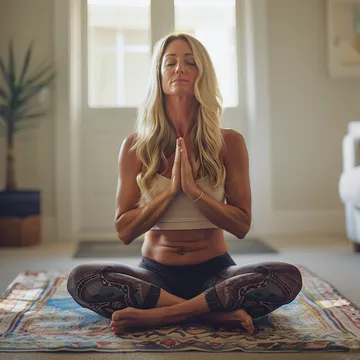
Foundation Poses for Beginners
By familiarizing yourself with these basic poses, you begin to cultivate body awareness, balance, and the ability to breathe through movements. The confidence gained from mastering these poses acts as a springboard to explore and transition into more advanced sequences.
Remember, the goal of beginner yoga poses is to create a strong and flexible base that supports your journey through the transformative art of yoga.
In this guide, we will explore four essential foundational poses that every aspiring yoga practitioner should know: Mountain Pose (Tadasana), Tree Pose (Vrksasana), Warrior I (Virabhadrasana I), and Child's Pose (Balasana). Let's begin by creating the solid groundwork required for a dynamic and fulfilling yoga practice.

Mountain Pose (Tadasana)
Mountain Pose, or Tadasana, is the quintessence of stillness and stability. It's the foundational pose from which all standing poses and inversions emerge.
Stand with your feet hip-distance apart, spreading your toes wide for a balanced foundation.
Engage your thighs, tuck your tailbone slightly, and imagine a line of energy passing through your body, connecting you from the earth to the sky.
With your shoulders relaxed and your arms by your sides, take several deep breaths, feeling the distribution of weight across the soles of your feet and the subtle lift of your core.
Tadasana is a deceivingly simple pose that actively works your entire body, cultivating posture awareness and a sense of inner steadiness. It's a grounding experience that prepares the mind and body for the practice ahead.
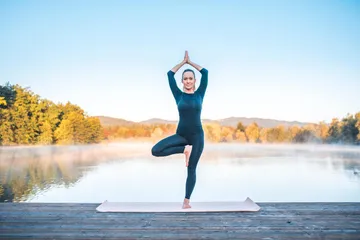
Tree Pose (Vrksasana)
The Tree Pose, or Vrksasana, introduces beginners to the concept of balance while standing on one foot. It's a delightful pose that mimics the stillness and strength of a tree, sharpening mental focus and promoting clarity.
Begin with your feet together.
Slowly shift your weight onto your left foot, lifting your right foot to rest on the inner left thigh.
Ensure your right knee points outward, creating a straight line from your pelvis to the foot on the ground.
Bring your hands together in a prayer position at your heart center.
If you feel stable, extend your arms overhead like branches reaching towards the sky.

Warrior I (Virabhadrasana I)
Warrior I, or Virabhadrasana I, is a powerful pose that represents a battle warrior, poised and ready for action.
Start by stepping your right foot forward into a lunge, keeping the back foot planted at a 45-degree angle.
Raise both arms overhead, reaching toward the sky while keeping fingers active and your gaze straight ahead.
Keep your front knee aligned over the ankle, and ensure that your hips are squared to the front of your mat.
Breathe deeply in Warrior I, feeling the stretch in the hip flexors of the back leg and the engagement of the front thigh.
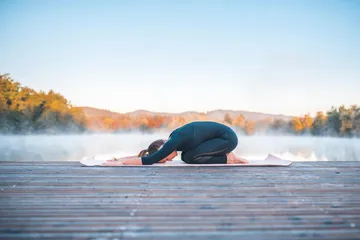
Child's Pose (Balasana)
Child's Pose, or Balasana, offers a moment of quiet retreat, allowing the body to rest and rejuvenate.
To come into Child's overlap your knees wider than your hips and sink your buttocks towards your heels.
Extend your arms forward, resting your forehead on the mat.
Breathe deeply, allowing each exhale to relax your body further into the pose.
Balasana is a restorative pose that can be used at any point during your practice when you need a break.
Standing Poses for Strength and Stability
Standing poses are a cornerstone of most yoga classes. These foundational postures are typically integrated at the beginning of a session to build heat, energizing the body and preparing it for more complex positions.
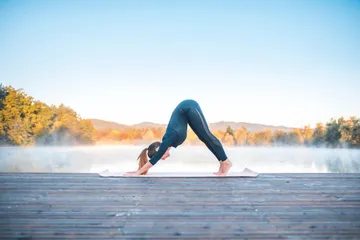
Downward-Facing Dog (Adho Mukha Svanasana)
Downward-Facing Dog is a classic yoga pose known for its ability to stretch and strengthen many parts of the body simultaneously.
As you lift your hips up and back, aim to elongate your spine—this invites a gentle lengthening that decompresses the vertebrae.
Ground through your palms with fingers wide, distributing the weight evenly across your hands, as you press your heels toward the mat.

Warrior II (Virabhadrasana II)
Warrior II is a pose that embodies strength and endurance. It shares some characteristics with Warrior I, such as the powerful work it does building the quadriceps, but it also opens up the hip flexors.
The practice of this pose begins rooted in Mountain Pose.
With an exhalation, step your left foot back about four feet, aligning your heels and turning your back foot out 90 degrees.
As you extend your arms to the side and gaze over your front fingers, breathe deeply to draw upon your inner strength and stability.
Ensure that your front knee tracks over the ankle and that your hips maintain squaring to the side of your mat.

Triangle Pose (Trikonasana)
Triangle Pose, or Trikonasana, is a symphony of strength and stretch.
By taking a wide stance with the legs, you create a robust base.
Pivot the right foot outward while the left foot remains closer to the body, forming the foundation of the triangle.
As you tip at the hips to reach your right hand down towards the ankle, shin, or the ground, your left arm reaches skyward—honing balance and stability.
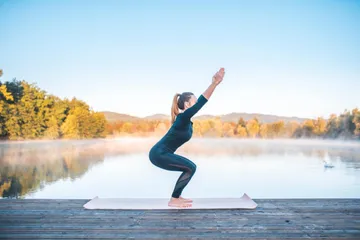
Chair Pose (Utkatasana)
Chair Pose, or Utkatasana, is an asana that mimics the act of sitting in an invisible chair.
To get into the Chair Pose, start from standing with your feet together.
Extend your arms skyward while simultaneously bending your knees and sending your hips back as though reaching for a chair.
Sitting Poses for Flexibility and Calmness
Sitting poses in yoga are instrumental for those looking to enhance flexibility, especially in the hips and hamstrings. These poses are particularly effective at the end of a yoga class when the body is thoroughly warmed up, allowing for a deeper stretch and greater hip and hamstring flexibility.

Seated Forward Bend (Paschimottanasana)
The Seated Forward Bend, or Paschimottanasana, is a foundational yoga pose that serves as a thorough stretch for the entire backside of the body, from the lower back through the hamstrings.
When entering Paschimottanasana, it's important to maintain a flat back and focus on tilting the pelvis forward rather than simply collapsing the spine.

Butterfly Pose (Baddha Konasana)
Butterfly Pose, or Baddha Konasana, is a gentle, seated stretch that involves placing the soles of the feet together with the knees wide apart, creating a diamond shape with the legs.
For those who find the pose challenging, props such as cushions or blocks can be used under the thighs for support, ensuring proper alignment and ease in the posture.

Easy Pose (Sukhasana)
Easy Pose, known as Sukhasana, may be misleading by name as it can pose a challenge for those unaccustomed to sitting on the floor.
This pose involves a simple cross-legged position on a yoga mat, with hands resting on the knees, palms facing upwards. It serves as a starting point for beginners to become mindful of their posture and comfort levels.

Corpse Pose (Savasana)
Savasana, known as Corpse Pose, is a crucial component of any yoga session, often serving as the final resting pose.
Lie on your back with arms at your sides and feet naturally splayed, cultivating an experience of deep rest.
Savasana is typically held from 30 seconds up to 10 minutes, allowing the benefits of the practice to sink in, ensuring a sense of serenity and rejuvenation that lingers beyond the yoga mat.
Yoga Practices to Improve Core Strength
Engaging and challenging poses such as Plank Pose act as the cornerstone of core development, aiding in the mastery of balances and arm-supported postures.

Plank Pose (Phalakasana)
Plank Pose, or Phalakasana, is a fundamental yoga posture that provides a comprehensive challenge for both core and upper body strength.
To perform Plank Pose correctly, start on all fours and then extend your legs back, one at a time, to form a straight line from your head to your heels.
Ensuring adequate alignment is critical; your palms should be pressed firmly into your mat directly beneath your shoulders.
Your arms should remain straight and assertive, promoting stability and creating a solid base.
Additionally, align your head neutrally with your gaze slightly forward or down to maintain a straight and elongated spine.

Boat Pose (Navasana)
Boat Pose, known in Sanskrit as Navasana, is another vital yoga pose for core engagement.
To begin, sit with your knees bent, feet flat on the floor, and then slowly lean back to balance on your sit bones.
Extend your arms forward and lift your legs off the ground, straightening them to a comfortable degree.
If maintaining straight legs is too challenging initially, there's an accessible variation—simply keep the knees bent.

Bridge Pose (Setu Bandha Sarvangasana)
Bridge Pose, or Setu Bandha Sarvangasana, serves not just as a gentle introduction to deeper backbends but also as a means of enhancing core and lower body strength.
When entering Bridge Pose, begin laid flat on your back, then press your feet into the ground and lift your hips skyward.
This activation of the leg muscles, along with the engagement of the core, hips, quads, and calves, provides vital support.
For added safety and therapeutic benefits, a yoga block or bolster can be positioned under the sacrum, offering support that can alleviate lower back tension and ease menstrual discomfort.

Benefits of Yoga for Beginners
Yoga is a nurturing practice that offers numerous benefits, particularly for those starting out. Beginners experience a physical loosening of tight muscles, which helps ease stiffness and encourages a fuller range of movement.
Beyond the physical, beginner yoga poses facilitate a powerful connection between the mind, body, and breath, fostering a sense of holistic well-being. These initial poses are designed to guide you to tune into your body, heightening awareness through the coordination of breath and movement.
Enhancing upper body strength
Yoga isn't limited to improving flexibility; it is also an effective tool for enhancing upper body strength. Poses in yoga often require you to support your weight using your arms and legs while engaging your core, which can lead to increased muscle development and strength. Regular practice of yoga can target and fortify multiple muscle groups at once, helping build up not only muscular arms and shoulders but also a strong back and core.
Balance poses particularly work on the abdominal region, which improves overall stability. The longevity and consistency of holding these poses generate a muscle burn that can lead to significant strength improvements over time. Yoga integrates poses that engage the shoulder blades and open up the chest, providing a gentle stretch while simultaneously working the upper body muscles, which is especially beneficial for those who spend long hours sitting at desks or using computers.
Improving flexibility and balance
Flexibility and balance are cornerstones in the practice of yoga. Beginner yoga poses focus on gently stretching the muscles, promoting increased flexibility throughout the body. By starting with foundational poses like the Downward-Facing Dog and simple standing poses, the flexibility in the hamstrings, shoulders, and hip flexors can gradually improve. Furthermore, poses such as the Tree Pose or Warrior series help in cultivating a sense of balance and proprioception, which are important for everyday movements and overall coordination.
Yoga encourages you to be mindful of your body alignment and to maintain equal weight distribution, which translates directly to improved balance. As you integrate yoga into their routine, you may find that your ability to balance both on and off the mat enhances, making daily activities easier and reducing the risk of falls or injuries.
Promoting relaxation and stress relief
A key benefit of yoga for beginners is its ability to combine physical exercises with mental relaxation and stress relief. Yoga practices employ deep breathing techniques which are instrumental in calming the nervous system and relaxing the mind. Regular yoga practice has been found to mitigate stress, anxiety, and depressive symptoms, significantly enhancing your quality of life.
The physical activities integrated into yoga routines are known to lower blood pressure, reduce cholesterol levels, and stabilize heart rates, contributing to better cardiovascular health. Additionally, the mental focus demanded by yoga helps to quiet the mind, facilitating improved sleep patterns and overall relaxation.
You might also like
Weekly lifestyle inspiration.
In your inbox.
We think you’ll like
Get inspired with more content like this
Lifestyle — Food & Drink
Comforting Creamy Potato Soup
Lifestyle — Food & Drink
Pumpkin Spiced Halloween Cookies: A Sweet and Spooky Treat
Lifestyle — Health & Wellness








